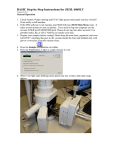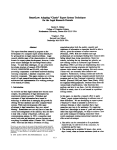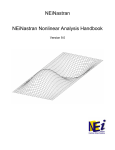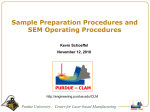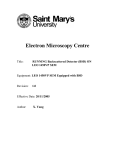Download Dell JSM-6060LV Operating instructions
Transcript
JEOL JSM-6060LV SCANNING ELECTRON MICROSCOPE Insert Nickname Here Operating Instructions J E O L J S M - 6 0 6 0 L V S C A N N I N G E L E C T R O N M I C R O S C O P E Table of Contents 1 Safety 2 5 INTRODUCTION 3 BACKG ROUND Background Information 4 References 4 3 SAMPL ES Sample Holders 7 Sample Preparation 7 4 OPERA TION Instrument Startup 8 Sample Loading 8 Getting an Image 9 Moving Around 9 Image Scanning 10 Zooming In (or Out) 10 Other Toolbar Buttons 10 System Shutdown 10 1 PHOTO GRAPHY Image Options 11 Lower Resolution (but quick) Photos 11 Higher Resolution (slower) Photos 12 J E O L J S M - 6 0 6 0 L V S C A N N I N G E L E C T R O N Introduction M I C R O S C O P E 1 T he JEOL JSM-6060LV is a state-of-the-art scanning electron microscope that features a low vacuum for observation of non-conductive specimens, a fully automated electron gun, a backscattered electron detector for atomic number contrast imaging, fully integrated digital control, motorized x-y stage, and a NORAN System 6 elemental analysis system (see separate operating instructions for the NORAN system). Best of all, the JEOL JSM-6060LV scanning electron microscope is user-friendly and easy to operate. Safety The scanning electron microscope is a relatively safe instrument.. You can do much more damage to it than it can do to you. When the electron beam is turned on, some x-rays are produced as a result of electron beam interaction with the sample, but these x-rays are of relatively low energy and do not escape the sample chamber. The instrument also produces some radio frequency energy. 2 J E O L J S M - 6 0 6 0 L V S C A N N I N G E L E C T R O N Background M I C R O S C O P E 2 The scanning electron microscope (SEM) is one of the most versatile instruments for the examination and analysis of the microstructural characteristics of solids. Although the SEM and optical microscope share the same primary function – making microstructural features and objects visible to the human eye – the scanning electron microscope offers some distinct advantages over the optical microscope. The SEM uses electrons rather than visible light waves (200 – 750 nm wavelength) for imaging, which allows for observation of relatively large sample features at low magnifications or very fine details (high resolution) at high magnifications. The SEM also offers a large depth of field that provides good focus over rough specimen surfaces. The large depth of focus provides a three-dimensional appearance of the specimen in a SEM compared to the nearly planar or two-dimensional imaging found in optical microscopes. In addition, many attachments are available for scanning electron microscopes, including x-ray spectrometers for chemical composition analysis, backscattered electron detectors for atomic number contrast, transmitted electron detectors, hot and cold stages for microscopic observation of high or low temperature phenomena, tensile testing stages for observation of deformation and fracture, and special stages for analysis of semiconductor devices. Disadvantages of the scanning electron microscope include relatively high initial, operational, and maintenance costs, a high vacuum operating atmosphere that is unsuitable for some specimens, and difficulty in preparing certain types of specimens. Figure 1 schematically illustrates image formation in the optical microscope and the scanning electron microscope. Figure 1. Basic image formation in an optical microscope and a scanning electron microscope. 3 J E O L J S M - 6 0 6 0 L V S C A N N I N G E L E C T R O N M I C R O S C O P E The basic components of a SEM are the vacuum system, electron gun, lens system, electron detector, imaging system, and the electronics associated with these components. The vacuum system is necessary to minimize the interference of air particles with the electron beam and to prevent rapid oxidation of the tungsten filament. The vacuum system consists of roughing pumps, an oil diffusion pump, and various vacuum fittings, valves and seals that provide a working pressure in the SEM of 10-6 to 10-4 Torr (10-4 to 10-2 Pa). Our SEM has a vacuum system that may be switched to low vacuum mode (close to atmospheric pressure). The electron gun in our JEOL SEM contains a tungsten filament that is heated with a filament power supply and maintained at a high negative voltage (typically 10-20 kV) during operation. When the tungsten filament is heated, electrons are emitted from the tip and accelerated to ground by the 10-20 kV potential between the filament and the anode. Figure 2 shows the typical configuration of an electron gun in a SEM. After electrons are emitted from the gun and accelerated down the SEM column in an electron beam, they are controlled and directed to the specimen by a series of electromagnetic lenses and apertures. When the electrons in the electron beam hit the specimen, a number of electronspecimen interactions may occur. Some of these interactions include elastic scattering of electrons, secondary electron emission (emission of loosely bound electrons of the conduction band), ionization of inner shell electrons Figure 2. Schematic illustration of SEM electron (produces x-rays and Auger electrons), and excitation of phonons (causes heating of the specimen). If a sample is thin enough, some electrons will be transmitted all the way through the sample. Different materials and sample geometries will produce different amounts or different types of secondary electrons, backscattered electrons, Auger electrons, transmitted electrons, and x-rays, and all of these interactions may be used for imaging or analysis of the sample. The most common type of imaging in a SEM is secondary electron imaging (SEI), which involves the use of a secondary electron detector. The secondary electron detector collects secondary electrons and some backscattered electrons that are emitted from the specimen surface, amplifies the detected signal, and converts the electron signal into a video signal that is sent to the monitor. References • • JEOL JSM-35CF Scanning Microscope Instruction Manual J. I. Goldstein, et al., Scanning Electron Microscopy and X-Ray Microanalysis, Plenum Press, New York (1981). 4 J E O L J S M - 6 0 6 0 L V S C A N N I N G E L E C T R O N M I C R O S C O P E Samples T 3 he JEOL JSM-6060LV in standard high vacuum operating mode can handle a variety of sample types. The low vacuum mode enables the instrument to handle nonconductive samples, including organic materials (polymers, etc.), ceramics and glasses, and biological samples. Sample Holders Please use clean, powder-free gloves when handling the sample holders and loading your samples into the instrument. Two different sample holders are available. The smaller sample holder is designed to take 10 mm diameter x 10 mm tall cylindrical sample mounts or other small specimens that fit into the same volume. We have a large number of aluminum cylindrical sample mounts for use with the smaller sample holder. The larger sample holder is approximately 32 mm in diameter x 10 mm tall, and is designed for creative attachment of larger specimens. It’s best if you can fit your samples onto one of the standard sample holders, but if not, other arrangements may be made (talk to Professor Stolk). Other types of sample holders are available. See Professor Stolk for information on ordering sample holders. Sample Preparation – Conductive Materials 1. Small samples that fit securely onto one of the standard sample holders are best. Use a precision saw to section larger materials to an appropriate size, if possible. 2. Remove excess lint, dust, moisture, and other debris from your specimen, unless you want to examine those things. 3. Use conductive carbon tape, carbon tabs, carbon paint, or copper tape to attach your sample to a sample holder or cylindrical sample mount. If you use carbon paint, please wait for the paint to dry (or use a heat gun or hair dryer) before you load the sample into the instrument. 4. A sample height approximately even with the top surface of the sample holder is recommended. With tall samples, you risk contacting one of the detectors or other sensitive interior components and causing major problems (and repair bills!). Sample Preparation – Non-conductive Materials 1. Small samples that fit securely onto one of the standard sample holders are best. Use a precision saw to section larger materials to an appropriate size, if possible. 5 J E O L J S M - 6 0 6 0 L V S C A N N I N G E L E C T R O N M I C R O S C O P E 2. Remove excess lint, dust, moisture, and other debris from your specimen, unless you want to examine those things. 3. Use the sputter coater to create a conductive gold coating on the surface of your sample. See separate operating instructions for the sputter coater. 4. After coating your sample, use conductive carbon tape, carbon tabs, carbon paint, or copper tape to attach your sample to a sample holder or cylindrical sample mount. If you use carbon paint, please wait for the paint to dry (or use a heat gun or hair dryer) before you load the sample into the instrument. 5. A sample height approximately even with the top surface of the sample holder is recommended. With tall samples, you risk contacting one of the detectors or other sensitive interior components and causing major problems (and repair bills!). 6 J E O L J S M - 6 0 6 0 L V S C A N N I N G E L E C T R O N Instrument Operation T M I C R O S C O P E 4 his section will walk you through the basic operation of the scanning electron microscope. You will follow a series of tasks that includes • Powering up the instrument, • Loading your sample, • Evacuating the chamber, • Turning on the electron gun, and • Gazing at some wonderful high magnification images. Instrument Startup 1. If the instrument is already turned on, skip to the next section on Sample Loading. If the instrument is off, continue to Step 2. 2. Turn on the water chiller. The on/off switch is on the front panel. The temperature should read between 65 and 69 degrees F. 3. Turn on the SEM by turning and releasing the key on the front panel of the instrument (it’s just like starting a car). 4. Turn on the Dell computer on the left and hit the ENTER key at the log on screen (no password necessary). Sample Loading 1. If the chamber is evacuated (EVAC button on the front of the instrument is lit green), press 2. 3. 4. 5. and hold the VENT button until it lights up yellow. This will vent the chamber. Wait for the VENT button to stop flashing (about 40 seconds). Open the chamber by grabbing the door assembly at the side depressions and carefully sliding the door assembly outwards. You should be able to see the brass, circular platform of the sample stage when you slide open the door. Slide your sample holder with sample attached onto the copper-colored dovetail on the stage. CAUTION: Adjust the sample height so that the top of the sample is well below the position of the interior chamber components (detectors, lenses, etc.). Use the z-axis control (the adjustment on the door assembly with the knob that is pointing straight up and the micrometer with horizontal divisions) for height adjustments. Steer clear of anything inside the chamber. Bumping interior components can cause thousands of dollars in damage to the instrument. Know your sample height, and know approximately how much clearance you have around your sample, particularly along the z-axis. 7 J E O L J S M - 6 0 6 0 L V S C A N N I N G E L E C T R O N M I C R O S C O P E 6. Close the chamber door by gently pushing it forward until it stops. 7. Press and hold the EVAC button (on the front of the instrument) until it lights up green. 8. WAIT for evacuation of the chamber (about 1 minute). While you’re waiting, go to the next section – Software. Getting an Image 1. Double click on the SEM Main Menu icon to open the SEM software. IMPORTANT NOTE: Nearly all of the basic SEM controls may be accessed by clicking on the standard toolbars buttons and the standard display items (buttons above the image, numbers at the bottom of the window, etc.). 2. When the chamber is properly evacuated, the HT button at the top left will be blue and read 3. 4. 5. 6. 7. 8. Ready. If the chamber is vented or still evacuating, the HT button will be grayed out and read Wait. Click on the blue HT-Ready button to turn on the electron beam. The button should turn green and read HT-ON. Adjust magnification to the lowest possible value (usually between 10X and 20X). Click on the blue AF-Focus button on the toolbar or the AUTO FOCUS button on the keypad. This should bring your specimen into focus. If it doesn’t, try turning on the COARSE button and adjusting the focus knob on the keypad. Click on the blue ACB to automatically adjust the contrast and brightness. Click on the blue AS-Stigma button for automatic astigmatism correction. You should have a focused image at this point. If so, congratulations…you’re an electron microscopist. If not, call your instructor or teaching assistant for help. IMPORTANT SETTINGS o Accelerating Voltage. Check the accelerating voltage value shown at the bottom of the window (Acc. Volt). If you’re happy with your voltage, then continue being happy. If you’d like to change the accelerating voltage, click once on the voltage number, then double click on the desired voltage. A setting of 15 kV works well for most specimens, but feel free experimenting with other accelerating voltages. o Spot Size. A spot size between 40 and 60 works well for most specimens, but feel free experimenting with the spot size value. You’ll need to adjust the focus, contrast, and brightness after you change the spot size value. Moving Around 1. The motorized x and y axes are amazing! If you want to move your specimen, simply double- click on the area of interest to re-center the image on this spot, or click and drag the image to move to a spot of interest. It’s kind of like Mapquest. 2. Rotation. Turn the small knob at the bottom of the chamber door assembly (between the x and y axis knobs) to rotate the stage. 8 J E O L J S M - 6 0 6 0 L V S C A N N I N G E L E C T R O N M I C R O S C O P E 3. Tilt. Turn the knob at the lower right side of the chamber door assembly to tilt your specimen. BE CAREFUL when adjusting the sample tilt – you don’t want to run your sample into anything inside the column. 4. Height. Sample height may be changed by manually adjusting the y-axis position knob at the top of the door assembly. BE CAREFUL when adjusting the sample height – you don’t want to run your sample into anything inside the column. 5. The FINE SHIFT joystick on the keypad is great for small position adjustments when you’re working at high magnification. 6. To view your location relative to the entire sample, click on the blue and white Stage button toward the left end of the toolbar. This opens a schematic image of the sample holder with your location marked. If the sample holder you’re using doesn’t appear, select the correct holder under the Holder menu. Image Scanning • Green Toolbar Buttons. The image scan rate may be changed to a number of different settings using the green buttons on the toolbar. Play with the scan rate buttons to see what they do. Scan 2 is a TV-like mode. Scan 3 is a slower scan with higher resolution. Zooming In (or Out) • To change magnification, use the MAGNIFICATION knob on the keypad or the blue Mag- and Mag+ buttons on the toolbar. Other Toolbar Buttons • • • The Gun button on toolbar will display the electron gun settings. The automatic settings usually work great, so don’t mess with these unless you know what you’re doing. The Recipe button on the toolbar automatically adjusts the instrument settings according to preset values that work well with various materials. If you’re not a creative e-beam cook, try these recipes, if you like. The Sample button on the toolbar provides control of the chamber VENT and EVAC (same as the buttons on the front of the instrument). System Shutdown 1. 2. 3. 4. 5. Click on the HT-On toolbar button to turn off the electron gun. Click on the “EXIT” toolbar button to exit the software. Vent the chamber. Remove your specimen. Close the chamber door and evacuate the chamber. Always leave the chamber under vacuum to prevent dust and debris from collecting on the stage and detectors. 6. Please leave the entire system (instrument, computer, and water chiller) running. Talk to Professor Jon Stolk or Professor Debbie Chachra if you need to or would like to shut down the system. 9 J E O L J S M - 6 0 6 0 L V S C A N N I N G E L E C T R O N M I C R O S C O P E Photography A 5 cquiring an image from the SEM is relatively easy, but there are quite a few options for live image scanning and corresponding image resolution. This section outlines several options for acquiring digital images of different resolutions, and it provides a few general tips for good SEM photos. Image Options The most commonly used options for digital images are outlined in the following table. Scanning Mode Scan3 Scan3 Scan3 Scan3 Scan4 Scan4 • • • • Scan Speed, seconds 10 (default) 10 (default) 20 20 80 (default) 80 (default) Image Resolution 640x480 640x480 1280x960 1280x960 1280x960 1280x960 Image Format jpg tif jpg tif jpg tif File Size 100k 300k 200k 1,200k 200k 1,200k The Scanning Mode is adjusted via the green toolbar buttons. Scan3 and Scan4 are the only modes recommended for photography. Images taken on the Scan4 mode are less grainy than those acquired in Scan3 mode. The Scan Speed is adjusted in the Scan…Scan Speed section of the Setup…Fundamental Setup pull down menu. The default scan time settings are 10s (640x480) for Scan3 and 80s (1280x960) for Scan4. Image Format is selected in the pull down box after the image is frozen and the Save button is pressed. Image Size is a function of both scan speed and image format. JPG images are relatively small, and TIF images are relatively large. JPG images generally work fine for most users. Lower Resolution (but quick) Photos 1. Press the green Scan2 button on the toolbar. 2. Adjust the focus, contrast, and brightness (or use the automatic features). It is good practice to focus the image at a higher magnification, then back down to the desired photo magnification. 3. Freeze the image by pressing the green Scan3 toolbar button followed by the green Freeze toolbar button. 10 J E O L J S M - 6 0 6 0 L V S C A N N I N G E L E C T R O N M I C R O S C O P E 4. Once the image is frozen, click the Save button above the image, select a save directory, type a filename, select a file format, and click Save. Higher Resolution (slower) Photos 1. Press the green Scan2 button on the toolbar. 2. Carefully adjust the focus and stigmation settings at a higher magnification. It is good practice to focus the image at a higher magnification, then back down to the desired photo magnification 3. Adjust the contrast, brightness (or use the automatic features). 4. Freeze the image by pressing the green Scan4 toolbar button. After about 80 seconds of high resolution image acquisition, the image will freeze. 5. click the Save button above the image, select a save directory, type a filename, select a file format, and click Save. 11












